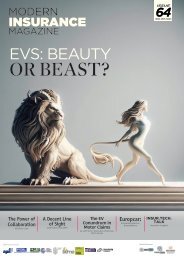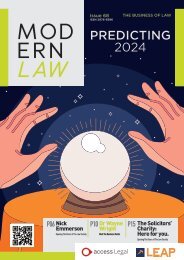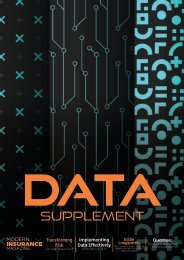Modern Insurance Magazine Issue 65
Create successful ePaper yourself
Turn your PDF publications into a flip-book with our unique Google optimized e-Paper software.
ASSOCIATIONS ASSEMBLE<br />
Fleur Thomas Rochester Hudd<br />
Title: President<br />
Title: National Technical Manager<br />
Association: London Forum of <strong>Insurance</strong><br />
Association:<br />
Lawyers<br />
Nationwide<br />
(FOIL)<br />
Bodyshop Repair<br />
Association (NBRA)<br />
The Use of AI in<br />
<strong>Insurance</strong><br />
As the use of AI in the insurance industry<br />
rises, its benefits are becoming increasingly<br />
clear. Insurers are now more productive and<br />
efficient than ever before, with innovative<br />
technologies enabling the sector to meet<br />
changing customer expectations and provide<br />
new solutions to emerging risks.<br />
New ways of collating and analysing customer data<br />
have been particularly impactful. Underwriting is more<br />
precise, risks can be measured and priced more easily,<br />
and claims handling is streamlined.<br />
But the digitisation of the insurance industry doesn’t<br />
come without legal risks. There will always be questions<br />
about how data is being used, and how well-protected<br />
it is against a security breach. The use of data is<br />
something customers worry about and naturally, this<br />
creates additional scrutiny, something that can lead<br />
to distrust if insurers aren’t careful. Therefore, it is<br />
important to ensure that data is being handled in the<br />
right way. Customers will also require reassurance<br />
through consistent communication, transparent data<br />
policies, and adherence to regulatory requirements.<br />
Having said that, the regulation of AI in insurance is<br />
an issue of its own. Technology is evolving rapidly, and<br />
it is very difficult for regulators to stay up to speed<br />
with the changes. They’re essentially always on the<br />
backfoot; by the time one issue has been addressed<br />
through regulatory measures, another product appears.<br />
These grey areas have implications from a compliance<br />
perspective, and create additional regulatory risks for<br />
insurers.<br />
In response, insurers are implementing strong AI<br />
frameworks to ensure data is being cleaned and used<br />
in an appropriate, ethical way. Doing this will help foster<br />
trusting relationships with consumers, and will allow<br />
insurers to mitigate the manifest risks of AI whilst also<br />
harnessing its full potential.<br />
Thomas Hudd<br />
Title: National Technical Manager<br />
Association: National Bodyshop Repair<br />
Association (NBRA)<br />
Cyber Risk in the<br />
Automotive Sector<br />
Cyber risk in the automotive sector refers to the<br />
vulnerabilities and potential threats associated<br />
with the increasing integration of digital<br />
technologies and connectivity in vehicles. As<br />
cars become more sophisticated and connected,<br />
they become vulnerable to cyber-attacks which<br />
can compromise the safety, security and privacy<br />
of drivers and passengers alike.<br />
Some of the key aspects of cyber risk in automotive<br />
include:<br />
Connected Car Systems. <strong>Modern</strong> vehicles often<br />
feature sophisticated onboard computer systems that<br />
control various functions, such as engine management,<br />
braking, steering, and infotainment. These systems are<br />
increasingly connected to the internet and other external<br />
networks, making them susceptible to hacking and<br />
unauthorised access.<br />
Remote Exploitation. Hackers can potentially gain<br />
unauthorised access to a vehicle’s systems remotely,<br />
exploiting vulnerabilities in software or through<br />
wireless connections such as Bluetooth, Wi-Fi, or<br />
cellular networks. Once access is gained, attackers can<br />
manipulate various vehicle functions, potentially leading<br />
to accidents or other dangerous situations which can<br />
affect public trust in the safety of connected vehicles.<br />
Data Privacy. Connected vehicles collect vast amounts<br />
of data about their occupants, including location,<br />
driving habits, and personal preferences. This data is<br />
often transmitted and stored in various systems, raising<br />
concerns about privacy and the potential for misuse if it<br />
falls into the wrong hands.<br />
Over-the-air (OTA) updates. While OTA updates<br />
can provide a convenient way to patch software<br />
vulnerabilities and add new features, they also<br />
introduce potential risks if not implemented securely. A<br />
compromised update mechanism could allow attackers<br />
to install malicious software on vehicles.<br />
To mitigate these risks, automotive manufacturers and<br />
suppliers must adopt robust cybersecurity measures<br />
throughout the design, development, manufacturing,<br />
and operational phases of a vehicle’s lifecycle. This<br />
includes implementing secure software development<br />
practices, conducting thorough risk assessments,<br />
implementing intrusion detection systems,<br />
and regularly updating software to<br />
address known vulnerabilities.<br />
MODERN INSURANCE | 35
















